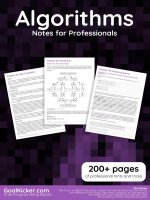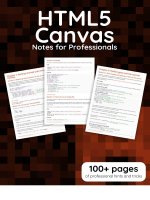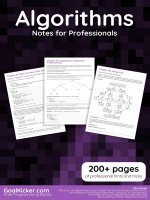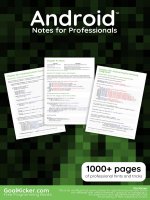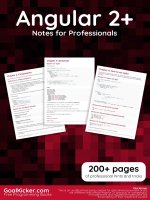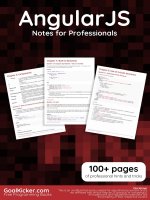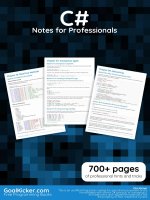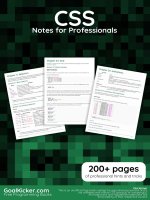Swift notes for professionals
Bạn đang xem bản rút gọn của tài liệu. Xem và tải ngay bản đầy đủ của tài liệu tại đây (2.7 MB, 291 trang )
Swift
Swift
Notes for Professionals
™
Notes for Professionals
200+ pages
of professional hints and tricks
GoalKicker.com
Free Programming Books
Disclaimer
This is an unocial free book created for educational purposes and is
not aliated with ocial Swift™ group(s) or company(s).
All trademarks and registered trademarks are
the property of their respective owners
Contents
About ................................................................................................................................................................................... 1
Chapter 1: Getting started with Swift Language .......................................................................................... 2
Section 1.1: Your first Swift program ............................................................................................................................ 2
Section 1.2: Your first program in Swift on a Mac (using a Playground) ................................................................. 3
Section 1.3: Your first program in Swift Playgrounds app on iPad ........................................................................... 7
Section 1.4: Installing Swift ............................................................................................................................................ 8
Section 1.5: Optional Value and Optional enum ......................................................................................................... 8
Chapter 2: Variables & Properties ..................................................................................................................... 10
Section 2.1: Creating a Variable ................................................................................................................................. 10
Section 2.2: Property Observers ................................................................................................................................ 10
Section 2.3: Lazy Stored Properties ........................................................................................................................... 11
Section 2.4: Property Basics ....................................................................................................................................... 11
Section 2.5: Computed Properties ............................................................................................................................. 12
Section 2.6: Local and Global Variables ................................................................................................................... 12
Section 2.7: Type Properties ....................................................................................................................................... 13
Chapter 3: Numbers .................................................................................................................................................. 14
Section 3.1: Number types and literals ...................................................................................................................... 14
Section 3.2: Convert numbers to/from strings ........................................................................................................ 15
Section 3.3: Rounding .................................................................................................................................................. 15
Section 3.4: Random number generation ................................................................................................................. 16
Section 3.5: Convert one numeric type to another .................................................................................................. 17
Section 3.6: Exponentiation ........................................................................................................................................ 17
Chapter 4: Strings and Characters ................................................................................................................... 18
Section 4.1: String & Character Literals ..................................................................................................................... 18
Section 4.2: Concatenate strings ............................................................................................................................... 19
Section 4.3: String Encoding and Decomposition .................................................................................................... 20
Section 4.4: Examine and compare strings .............................................................................................................. 20
Section 4.5: Reversing Strings .................................................................................................................................... 21
Section 4.6: Check if String contains Characters from a Defined Set .................................................................... 21
Section 4.7: String Iteration ........................................................................................................................................ 22
Section 4.8: Splitting a String into an Array .............................................................................................................. 24
Section 4.9: Unicode .................................................................................................................................................... 24
Section 4.10: Converting Swift string to a number type .......................................................................................... 25
Section 4.11: Convert String to and from Data / NSData ........................................................................................ 25
Section 4.12: Formatting Strings ................................................................................................................................ 26
Section 4.13: Uppercase and Lowercase Strings ...................................................................................................... 26
Section 4.14: Remove characters from a string not defined in Set ........................................................................ 27
Section 4.15: Count occurrences of a Character into a String ................................................................................ 27
Section 4.16: Remove leading and trailing WhiteSpace and NewLine ................................................................... 27
Chapter 5: Booleans .................................................................................................................................................. 29
Section 5.1: What is Bool? ........................................................................................................................................... 29
Section 5.2: Booleans and Inline Conditionals .......................................................................................................... 29
Section 5.3: Boolean Logical Operators .................................................................................................................... 30
Section 5.4: Negate a Bool with the prefix ! operator .............................................................................................. 30
Chapter 6: Arrays ....................................................................................................................................................... 31
Section 6.1: Basics of Arrays ....................................................................................................................................... 31
Section 6.2: Extracting values of a given type from an Array with flatMap(_:) ................................................... 32
Section 6.3: Combining an Array's elements with reduce(_:combine:) ................................................................. 32
Section 6.4: Flattening the result of an Array transformation with flatMap(_:) ................................................... 33
Section 6.5: Lazily flattening a multidimensional Array with flatten() ................................................................... 33
Section 6.6: Filtering out nil from an Array transformation with flatMap(_:) ....................................................... 34
Section 6.7: Subscripting an Array with a Range ..................................................................................................... 34
Section 6.8: Removing element from an array without knowing it's index ........................................................... 35
Section 6.9: Sorting an Array of Strings .................................................................................................................... 35
Section 6.10: Accessing indices safely ....................................................................................................................... 36
Section 6.11: Filtering an Array ................................................................................................................................... 37
Section 6.12: Transforming the elements of an Array with map(_:) ...................................................................... 37
Section 6.13: Useful Methods ...................................................................................................................................... 38
Section 6.14: Sorting an Array .................................................................................................................................... 38
Section 6.15: Finding the minimum or maximum element of an Array ................................................................. 39
Section 6.16: Modifying values in an array ............................................................................................................... 40
Section 6.17: Comparing 2 Arrays with zip ................................................................................................................ 40
Section 6.18: Grouping Array values .......................................................................................................................... 41
Section 6.19: Value Semantics .................................................................................................................................... 42
Section 6.20: Accessing Array Values ....................................................................................................................... 42
Chapter 7: Tuples ........................................................................................................................................................ 44
Section 7.1: What are Tuples? .................................................................................................................................... 44
Section 7.2: Decomposing into individual variables ................................................................................................ 44
Section 7.3: Tuples as the Return Value of Functions ............................................................................................. 45
Section 7.4: Using a typealias to name your tuple type ......................................................................................... 45
Section 7.5: Swapping values ..................................................................................................................................... 46
Section 7.6: Tuples as Case in Switch ........................................................................................................................ 46
Chapter 8: Enums ....................................................................................................................................................... 48
Section 8.1: Basic enumerations ................................................................................................................................. 48
Section 8.2: Enums with associated values .............................................................................................................. 48
Section 8.3: Indirect payloads .................................................................................................................................... 49
Section 8.4: Raw and Hash values ............................................................................................................................ 50
Section 8.5: Initializers ................................................................................................................................................. 51
Section 8.6: Enumerations share many features with classes and structures ..................................................... 52
Section 8.7: Nested Enumerations ............................................................................................................................. 53
Chapter 9: Structs ...................................................................................................................................................... 54
Section 9.1: Structs are value types ........................................................................................................................... 54
Section 9.2: Accessing members of struct ................................................................................................................ 54
Section 9.3: Basics of Structs ..................................................................................................................................... 54
Section 9.4: Mutating a Struct .................................................................................................................................... 55
Section 9.5: Structs cannot inherit ............................................................................................................................. 55
Chapter 10: Sets ........................................................................................................................................................... 57
Section 10.1: Declaring Sets ........................................................................................................................................ 57
Section 10.2: Performing operations on sets ............................................................................................................ 57
Section 10.3: CountedSet ............................................................................................................................................. 58
Section 10.4: Modifying values in a set ...................................................................................................................... 58
Section 10.5: Checking whether a set contains a value ........................................................................................... 58
Section 10.6: Adding values of my own type to a Set .............................................................................................. 58
Chapter 11: Dictionaries ........................................................................................................................................... 60
Section 11.1: Declaring Dictionaries ............................................................................................................................ 60
Section 11.2: Accessing Values .................................................................................................................................... 60
Section 11.3: Change Value of Dictionary using Key ................................................................................................ 61
Section 11.4: Get all keys in Dictionary ....................................................................................................................... 61
Section 11.5: Modifying Dictionaries ........................................................................................................................... 61
Section 11.6: Merge two dictionaries .......................................................................................................................... 62
Chapter 12: Switch ...................................................................................................................................................... 63
Section 12.1: Switch and Optionals ............................................................................................................................. 63
Section 12.2: Basic Use ................................................................................................................................................ 63
Section 12.3: Matching a Range ................................................................................................................................. 63
Section 12.4: Partial matching .................................................................................................................................... 64
Section 12.5: Using the where statement in a switch ............................................................................................... 65
Section 12.6: Matching Multiple Values ...................................................................................................................... 65
Section 12.7: Switch and Enums ................................................................................................................................. 66
Section 12.8: Switches and tuples .............................................................................................................................. 66
Section 12.9: Satisfy one of multiple constraints using switch ................................................................................ 67
Section 12.10: Matching based on class - great for prepareForSegue .................................................................. 67
Section 12.11: Switch fallthroughs ............................................................................................................................... 68
Chapter 13: Optionals ................................................................................................................................................ 69
Section 13.1: Types of Optionals ................................................................................................................................. 69
Section 13.2: Unwrapping an Optional ...................................................................................................................... 69
Section 13.3: Nil Coalescing Operator ........................................................................................................................ 71
Section 13.4: Optional Chaining .................................................................................................................................. 71
Section 13.5: Overview - Why Optionals? .................................................................................................................. 72
Chapter 14: Conditionals ......................................................................................................................................... 74
Section 14.1: Optional binding and "where" clauses ................................................................................................. 74
Section 14.2: Using Guard ........................................................................................................................................... 75
Section 14.3: Basic conditionals: if-statements ......................................................................................................... 75
Section 14.4: Ternary operator ................................................................................................................................... 76
Section 14.5: Nil-Coalescing Operator ....................................................................................................................... 77
Chapter 15: Error Handling .................................................................................................................................... 78
Section 15.1: Error handling basics ............................................................................................................................. 78
Section 15.2: Catching dierent error types ............................................................................................................. 79
Section 15.3: Catch and Switch Pattern for Explicit Error Handling ........................................................................ 80
Section 15.4: Disabling Error Propagation ................................................................................................................ 81
Section 15.5: Create custom Error with localized description ................................................................................. 81
Chapter 16: Loops ....................................................................................................................................................... 83
Section 16.1: For-in loop ............................................................................................................................................... 83
Section 16.2: Repeat-while loop ................................................................................................................................. 85
Section 16.3: For-in loop with filtering ........................................................................................................................ 85
Section 16.4: Sequence Type forEach block ............................................................................................................. 86
Section 16.5: while loop ............................................................................................................................................... 86
Section 16.6: Breaking a loop ..................................................................................................................................... 87
Chapter 17: Protocols ................................................................................................................................................ 88
Section 17.1: Protocol Basics ....................................................................................................................................... 88
Section 17.2: Delegate pattern ................................................................................................................................... 90
Section 17.3: Associated type requirements ............................................................................................................. 91
Section 17.4: Class-Only Protocols ............................................................................................................................. 93
Section 17.5: Protocol extension for a specific conforming class ........................................................................... 94
Section 17.6: Using the RawRepresentable protocol (Extensible Enum) ............................................................... 94
Section 17.7: Implementing Hashable protocol ........................................................................................................ 95
Chapter 18: Functions ............................................................................................................................................... 97
Section 18.1: Basic Use ................................................................................................................................................. 97
Section 18.2: Functions with Parameters ................................................................................................................... 97
Section 18.3: Subscripts ............................................................................................................................................... 98
Section 18.4: Methods .................................................................................................................................................. 99
Section 18.5: Variadic Parameters ........................................................................................................................... 100
Section 18.6: Operators are Functions .................................................................................................................... 100
Section 18.7: Passing and returning functions ........................................................................................................ 101
Section 18.8: Function types ..................................................................................................................................... 101
Section 18.9: Inout Parameters ................................................................................................................................ 101
Section 18.10: Throwing Errors ................................................................................................................................. 101
Section 18.11: Returning Values ................................................................................................................................ 102
Section 18.12: Trailing Closure Syntax ..................................................................................................................... 102
Section 18.13: Functions With Closures .................................................................................................................... 103
Chapter 19: Extensions ........................................................................................................................................... 105
Section 19.1: What are Extensions? .......................................................................................................................... 105
Section 19.2: Variables and functions ...................................................................................................................... 105
Section 19.3: Initializers in Extensions ...................................................................................................................... 106
Section 19.4: Subscripts ............................................................................................................................................. 106
Section 19.5: Protocol extensions ............................................................................................................................. 106
Section 19.6: Restrictions .......................................................................................................................................... 107
Section 19.7: What are extensions and when to use them .................................................................................... 107
Chapter 20: Classes ................................................................................................................................................. 109
Section 20.1: Defining a Class .................................................................................................................................. 109
Section 20.2: Properties and Methods .................................................................................................................... 109
Section 20.3: Reference Semantics ......................................................................................................................... 109
Section 20.4: Classes and Multiple Inheritance ...................................................................................................... 110
Section 20.5: deinit .................................................................................................................................................... 111
Chapter 21: Type Casting ...................................................................................................................................... 112
Section 21.1: Downcasting ......................................................................................................................................... 112
Section 21.2: Type casting in Swift Language ........................................................................................................ 112
Section 21.3: Upcasting ............................................................................................................................................. 114
Section 21.4: Example of using a downcast on a function parameter involving subclassing ........................... 114
Section 21.5: Casting with switch .............................................................................................................................. 115
Chapter 22: Generics ............................................................................................................................................... 116
Section 22.1: The Basics of Generics ....................................................................................................................... 116
Section 22.2: Constraining Generic Placeholder Types ........................................................................................ 117
Section 22.3: Generic Class Examples ..................................................................................................................... 118
Section 22.4: Using Generics to Simplify Array Functions .................................................................................... 119
Section 22.5: Advanced Type Constraints .............................................................................................................. 119
Section 22.6: Generic Class Inheritance .................................................................................................................. 120
Section 22.7: Use generics to enhance type-safety .............................................................................................. 121
Chapter 23: OptionSet ............................................................................................................................................ 122
Section 23.1: OptionSet Protocol .............................................................................................................................. 122
Chapter 24: Reading & Writing JSON ............................................................................................................ 123
Section 24.1: JSON Serialization, Encoding, and Decoding with Apple Foundation and the Swift Standard
Library ................................................................................................................................................................ 123
Section 24.2: SwiftyJSON ......................................................................................................................................... 126
Section 24.3: Freddy ................................................................................................................................................. 127
Section 24.4: JSON Parsing Swift 3 ......................................................................................................................... 129
Section 24.5: Simple JSON parsing into custom objects ...................................................................................... 131
Section 24.6: Arrow ................................................................................................................................................... 132
Chapter 25: Advanced Operators .................................................................................................................... 135
Section 25.1: Bitwise Operators ................................................................................................................................ 135
Section 25.2: Custom Operators .............................................................................................................................. 136
Section 25.3: Overflow Operators ........................................................................................................................... 137
Section 25.4: Commutative Operators .................................................................................................................... 137
Section 25.5: Overloading + for Dictionaries .......................................................................................................... 138
Section 25.6: Precedence of standard Swift operators ......................................................................................... 138
Chapter 26: Method Swizzling ............................................................................................................................ 140
Section 26.1: Extending UIViewController and Swizzling viewDidLoad ................................................................ 140
Section 26.2: Basics of Swift Swizzling .................................................................................................................... 141
Section 26.3: Basics of Swizzling - Objective-C ...................................................................................................... 141
Chapter 27: Reflection ........................................................................................................................................... 143
Section 27.1: Basic Usage for Mirror ........................................................................................................................ 143
Section 27.2: Getting type and names of properties for a class without having to instantiate it .................... 143
Chapter 28: Access Control ................................................................................................................................. 147
Section 28.1: Basic Example using a Struct ............................................................................................................. 147
Section 28.2: Subclassing Example ......................................................................................................................... 148
Section 28.3: Getters and Setters Example ............................................................................................................ 148
Chapter 29: Closures ............................................................................................................................................... 149
Section 29.1: Closure basics ...................................................................................................................................... 149
Section 29.2: Syntax variations ................................................................................................................................ 150
Section 29.3: Passing closures into functions ......................................................................................................... 150
Section 29.4: Captures, strong/weak references, and retain cycles ................................................................... 152
Section 29.5: Using closures for asynchronous coding ........................................................................................ 153
Section 29.6: Closures and Type Alias .................................................................................................................... 154
Chapter 30: Initializers ........................................................................................................................................... 155
Section 30.1: Convenience init .................................................................................................................................. 155
Section 30.2: Setting default property values ........................................................................................................ 157
Section 30.3: Customizing initialization with parameters ...................................................................................... 158
Section 30.4: Throwable Initilizer ............................................................................................................................. 159
Chapter 31: Associated Objects ......................................................................................................................... 160
Section 31.1: Property, in a protocol extension, achieved using associated object ............................................ 160
Chapter 32: Concurrency ...................................................................................................................................... 163
Section 32.1: Obtaining a Grand Central Dispatch (GCD) queue ......................................................................... 163
Section 32.2: Concurrent Loops ............................................................................................................................... 163
Section 32.3: Running tasks in a Grand Central Dispatch (GCD) queue ............................................................. 164
Section 32.4: Running Tasks in an OperationQueue ............................................................................................. 166
Section 32.5: Creating High-Level Operations ....................................................................................................... 167
Chapter 33: Getting Started with Protocol Oriented Programming .............................................. 169
Section 33.1: Using protocols as first class types ................................................................................................... 169
Section 33.2: Leveraging Protocol Oriented Programming for Unit Testing ...................................................... 172
Chapter 34: Functional Programming in Swift .......................................................................................... 174
Section 34.1: Extracting a list of names from a list of Person(s) .......................................................................... 174
Section 34.2: Traversing ........................................................................................................................................... 174
Section 34.3: Filtering ................................................................................................................................................ 174
Section 34.4: Using Filter with Structs ..................................................................................................................... 175
Section 34.5: Projecting ............................................................................................................................................ 176
Chapter 35: Function as first class citizens in Swift ................................................................................ 178
Section 35.1: Assigning function to a variable ........................................................................................................ 178
Section 35.2: Passing function as an argument to another function, thus creating a Higher-Order Function
............................................................................................................................................................................. 179
Section 35.3: Function as return type from another function .............................................................................. 179
Chapter 36: Blocks ................................................................................................................................................... 180
Section 36.1: Non-escaping closure ......................................................................................................................... 180
Section 36.2: Escaping closure ................................................................................................................................. 180
Chapter 37: The Defer Statement ................................................................................................................... 182
Section 37.1: When to use a defer statement ......................................................................................................... 182
Section 37.2: When NOT to use a defer statement ............................................................................................... 182
Chapter 38: Style Conventions .......................................................................................................................... 183
Section 38.1: Fluent Usage ........................................................................................................................................ 183
Section 38.2: Clear Usage ........................................................................................................................................ 184
Section 38.3: Capitalization ...................................................................................................................................... 185
Chapter 39: NSRegularExpression in Swift .................................................................................................. 187
Section 39.1: Extending String to do simple pattern matching ............................................................................. 187
Section 39.2: Basic Usage ........................................................................................................................................ 188
Section 39.3: Replacing Substrings .......................................................................................................................... 188
Section 39.4: Special Characters ............................................................................................................................. 189
Section 39.5: Validation ............................................................................................................................................ 189
Section 39.6: NSRegularExpression for mail validation ........................................................................................ 189
Chapter 40: RxSwift ................................................................................................................................................ 191
Section 40.1: Disposing ............................................................................................................................................. 191
Section 40.2: RxSwift basics ..................................................................................................................................... 191
Section 40.3: Creating observables ......................................................................................................................... 192
Section 40.4: Bindings ............................................................................................................................................... 193
Section 40.5: RxCocoa and ControlEvents ............................................................................................................. 193
Chapter 41: Swift Package Manager .............................................................................................................. 196
Section 41.1: Creation and usage of a simple Swift package ................................................................................ 196
Chapter 42: Working with C and Objective-C ............................................................................................ 198
Section 42.1: Use a module map to import C headers .......................................................................................... 198
Section 42.2: Using Objective-C classes from Swift code ..................................................................................... 198
Section 42.3: Specify a bridging header to swiftc .................................................................................................. 200
Section 42.4: Use the C standard library ................................................................................................................ 200
Section 42.5: Fine-grained interoperation between Objective-C and Swift ........................................................ 200
Section 42.6: Using Swift classes from Objective-C code ..................................................................................... 201
Chapter 43: Documentation markup ............................................................................................................. 203
Section 43.1: Class documentation .......................................................................................................................... 203
Section 43.2: Documentation styles ........................................................................................................................ 203
Chapter 44: Typealias ........................................................................................................................................... 207
Section 44.1: typealias for closures with parameters ............................................................................................ 207
Section 44.2: typealias for empty closures ............................................................................................................ 207
Section 44.3: typealias for other types ................................................................................................................... 207
Chapter 45: Dependency Injection .................................................................................................................. 208
Section 45.1: Dependency Injection with View Controllers .................................................................................... 208
Section 45.2: Dependency Injection Types ............................................................................................................. 211
Chapter 46: Caching on disk space ................................................................................................................. 214
Section 46.1: Reading ................................................................................................................................................ 214
Section 46.2: Saving .................................................................................................................................................. 214
Chapter 47: Algorithms with Swift .................................................................................................................. 215
Section 47.1: Sorting .................................................................................................................................................. 215
Section 47.2: Insertion Sort ....................................................................................................................................... 218
Section 47.3: Selection sort ....................................................................................................................................... 218
Section 47.4: Asymptotic analysis ........................................................................................................................... 219
Section 47.5: Quick Sort - O(n log n) complexity time .......................................................................................... 219
Section 47.6: Graph, Trie, Stack ............................................................................................................................... 220
Chapter 48: Swift Advance functions ............................................................................................................ 234
Section 48.1: Flatten multidimensional array ......................................................................................................... 234
Section 48.2: Introduction with advance functions ................................................................................................ 234
Chapter 49: Completion Handler ..................................................................................................................... 236
Section 49.1: Completion handler with no input argument ................................................................................... 236
Section 49.2: Completion handler with input argument ........................................................................................ 236
Chapter 50: Swift HTTP server by Kitura ..................................................................................................... 238
Section 50.1: Hello world application ....................................................................................................................... 238
Chapter 51: Generate UIImage of Initials from String ........................................................................... 241
Section 51.1: InitialsImageFactory ............................................................................................................................ 241
Chapter 52: Design Patterns - Creational .................................................................................................... 242
Section 52.1: Singleton .............................................................................................................................................. 242
Section 52.2: Builder Pattern .................................................................................................................................... 242
Section 52.3: Factory Method .................................................................................................................................. 248
Section 52.4: Observer .............................................................................................................................................. 249
Section 52.5: Chain of responsibility ........................................................................................................................ 250
Section 52.6: Iterator ................................................................................................................................................. 252
Chapter 53: Design Patterns - Structural .................................................................................................... 253
Section 53.1: Adapter ................................................................................................................................................. 253
Section 53.2: Facade ................................................................................................................................................. 253
Chapter 54: (Unsafe) Buer Pointers ............................................................................................................ 255
Section 54.1: UnsafeMutablePointer ........................................................................................................................ 255
Section 54.2: Practical Use-Case for Buer Pointers ............................................................................................ 256
Chapter 55: Cryptographic Hashing ............................................................................................................... 257
Section 55.1: HMAC with MD5, SHA1, SHA224, SHA256, SHA384, SHA512 (Swift 3) ............................................. 257
Section 55.2: MD2, MD4, MD5, SHA1, SHA224, SHA256, SHA384, SHA512 (Swift 3) ............................................. 258
Chapter 56: AES encryption ................................................................................................................................ 260
Section 56.1: AES encryption in CBC mode with a random IV (Swift 3.0) ............................................................ 260
Section 56.2: AES encryption in CBC mode with a random IV (Swift 2.3) ........................................................... 262
Section 56.3: AES encryption in ECB mode with PKCS7 padding ......................................................................... 264
Chapter 57: PBKDF2 Key Derivation ............................................................................................................... 266
Section 57.1: Password Based Key Derivation 2 (Swift 3) ..................................................................................... 266
Section 57.2: Password Based Key Derivation 2 (Swift 2.3) ................................................................................. 267
Section 57.3: Password Based Key Derivation Calibration (Swift 2.3) ................................................................. 268
Section 57.4: Password Based Key Derivation Calibration (Swift 3) .................................................................... 268
Chapter 58: Logging in Swift .............................................................................................................................. 270
Section 58.1: dump .................................................................................................................................................... 270
Section 58.2: Debug Print ......................................................................................................................................... 271
Section 58.3: print() vs dump() ................................................................................................................................ 272
Section 58.4: print vs NSLog .................................................................................................................................... 272
Chapter 59: Memory Management ................................................................................................................. 274
Section 59.1: Reference Cycles and Weak References ......................................................................................... 274
Section 59.2: Manual Memory Management ......................................................................................................... 275
Chapter 60: Performance .................................................................................................................................... 276
Section 60.1: Allocation Performance ...................................................................................................................... 276
Credits ............................................................................................................................................................................ 278
You may also like ...................................................................................................................................................... 282
About
Please feel free to share this PDF with anyone for free,
latest version of this book can be downloaded from:
/>
This Swift™ Notes for Professionals book is compiled from Stack Overflow
Documentation, the content is written by the beautiful people at Stack Overflow.
Text content is released under Creative Commons BY-SA, see credits at the end
of this book whom contributed to the various chapters. Images may be copyright
of their respective owners unless otherwise specified
This is an unofficial free book created for educational purposes and is not
affiliated with official Swift™ group(s) or company(s) nor Stack Overflow. All
trademarks and registered trademarks are the property of their respective
company owners
The information presented in this book is not guaranteed to be correct nor
accurate, use at your own risk
Please send feedback and corrections to
GoalKicker.com – Swift™ Notes for Professionals
1
Chapter 1: Getting started with Swift
Language
Swift Version
Xcode Version Release Date
development began (first commit) 2010-07-17
1.0
Xcode 6
2014-06-02
1.1
Xcode 6.1
2014-10-16
1.2
Xcode 6.3
2015-02-09
2.0
Xcode 7
2015-06-08
2.1
Xcode 7.1
2015-09-23
open-source debut
-
2015-12-03
2.2
Xcode 7.3
2016-03-21
2.3
Xcode 8
2016-09-13
3.0
Xcode 8
2016-09-13
3.1
Xcode 8.3
2017-03-27
4.0
Xcode 9
2017-11-19
4.1
Xcode 9.3
2018-03-29
Section 1.1: Your first Swift program
Write your code in a file named hello.swift:
print("Hello, world!")
To compile and run a script in one step, use swift from the terminal (in a directory where this file is located):
To launch a terminal, press CTRL + ALT + T on Linux, or find it in Launchpad on macOS. To change
directory, enter cddirectory_name (or cd .. to go back)
$ swift hello.swift
Hello, world!
A compiler is a computer program (or a set of programs) that transforms source code written in a
programming language (the source language) into another computer language (the target language), with
the latter often having a binary form known as object code. (Wikipedia)
To compile and run separately, use swiftc:
$ swiftc hello.swift
This will compile your code into hello file. To run it, enter ./, followed by a filename.
$ ./hello
Hello, world!
Or use the swift REPL (Read-Eval-Print-Loop), by typing swift from the command line, then entering your
code in the interpreter:
GoalKicker.com – Swift™ Notes for Professionals
2
Code:
func greet(name: String, surname: String) {
print("Greetings \(name) \(surname)")
}
let myName = "Homer"
let mySurname = "Simpson"
greet(name: myName, surname: mySurname)
Let's break this large code into pieces:
func greet(name: String, surname: String) { // function body } - create a function that
takes a name and a surname.
print("Greetings \(name) \(surname)") - This prints out to the console "Greetings ", then name,
then surname. Basically \(variable_name) prints out that variable's value.
let myName = "Homer" and let mySurname = "Simpson" - create constants (variables which value
you can't change) using let with names: myName, mySurname and values: "Homer", "Simpson"
respectively.
greet(name: myName, surname: mySurname) - calls a function that we created earlier supplying the
values of constants myName, mySurname.
Running it using REPL:
$ swift
Welcome to Apple Swift. Type :help for assistance.
1> func greet(name: String, surname: String) {
2.
print("Greetings \(name) \(surname)")
3. }
4>
5> let myName = "Homer"
myName: String = "Homer"
6> let mySurname = "Simpson"
mySurname: String = "Simpson"
7> greet(name: myName, surname: mySurname)
Greetings Homer Simpson
8> ^D
Press CTRL + D to quit from REPL.
Section 1.2: Your first program in Swift on a Mac (using a
Playground)
From your Mac, download and install Xcode from the Mac App Store following this link.
After the installation is complete, open Xcode and select Get started with a Playground:
GoalKicker.com – Swift™ Notes for Professionals
3
On the next panel, you can give your Playground a name or you can leave it MyPlayground and press Next:
Select a location where to save the Playground and press Create:
GoalKicker.com – Swift™ Notes for Professionals
4
The Playground will open and your screen should look something like this:
GoalKicker.com – Swift™ Notes for Professionals
5
Now that the Playground is on the screen, press ⇧ + cmd + Y to show the Debug Area.
Finally delete the text inside Playground and type:
print("Hello world")
You should see 'Hello world' in the Debug Area and "Hello world\n" in the right Sidebar:
GoalKicker.com – Swift™ Notes for Professionals
6
Congratulations! You've created your first program in Swift!
Section 1.3: Your first program in Swift Playgrounds app on
iPad
Swift Playgrounds app is a great way to get started coding Swift on the go. To use it:
1- Download Swift Playgrounds for iPad from App Store.
GoalKicker.com – Swift™ Notes for Professionals
7
2- Open the app.
3- In the My Playgrounds tab, tap + on the top left corner and then select Blank template.
4- Enter your code.
5- Tap Run My Code to run your code.
6- At the front of each line, the result will be stored in a small square. Tap it to reveal the result.
7- To step slowly through code to trace it, tap the button next to Run My Code.
Section 1.4: Installing Swift
First, download the compiler and components.
Next, add Swift to your path. On macOS, the default location for the downloadable toolchain is
/Library/Developer/Toolchains. Run the following command in Terminal:
export PATH=/Library/Developer/Toolchains/swift-latest.xctoolchain/usr/bin:"${PATH}"
On Linux, you will need to install clang:
$ sudo apt-get install clang
If you installed the Swift toolchain to a directory other than the system root, you will need to run the following
command, using the actual path of your Swift installation:
$ export PATH=/path/to/Swift/usr/bin:"${PATH}"
You can verify you have the current version of Swift by running this command:
$ swift --version
Section 1.5: Optional Value and Optional enum
Optionals type, which handles the absence of a value. Optionals say either "there is a value, and it equals x" or
"there isn't a value at all".
GoalKicker.com – Swift™ Notes for Professionals
8
An Optional is a type on its own, actually one of Swift’s new super-powered enums. It has two possible values, None
and Some(T), where T is an associated value of the correct data type available in Swift.
Let's have a look at this piece of code for example:
let x: String? = "Hello World"
if let y = x {
print(y)
}
In fact if you add a print(x.dynamicType) statement in the code above you'll see this in the console:
Optional<String>
String? is actually syntactic sugar for Optional, and Optional is a type in its own right.
Here's a simplified version of the header of Optional, which you can see by command-clicking on the word Optional
in your code from Xcode:
enum Optional<Wrapped> {
/// The absence of a value.
case none
/// The presence of a value, stored as `Wrapped`.
case some(Wrapped)
}
Optional is actually an enum, defined in relation to a generic type Wrapped. It has two cases: .none to represent the
absence of a value, and .some to represent the presence of a value, which is stored as its associated value of type
Wrapped.
Let me go through it again: String? is not a String but an Optional<String>.The fact that Optional is a type
means that it has its own methods, for example map and flatMap.
GoalKicker.com – Swift™ Notes for Professionals
9
Chapter 2: Variables & Properties
Section 2.1: Creating a Variable
Declare a new variable with var, followed by a name, type, and value:
var num: Int = 10
Variables can have their values changed:
num = 20 // num now equals 20
Unless they're defined with let:
let num: Int = 10 // num cannot change
Swift infers the type of variable, so you don't always have to declare variable type:
let ten = 10 // num is an Int
let pi = 3.14 // pi is a Double
let floatPi: Float = 3.14 // floatPi is a Float
Variable names aren't restricted to letters and numbers - they can also contain most other unicode characters,
although there are some restrictions
Constant and variable names cannot contain whitespace characters, mathematical symbols, arrows,
private-use (or invalid) Unicode code points, or line- and box-drawing characters. Nor can they begin with
a number
Source developer.apple.com
var π: Double = 3.14159
var
: String = "Apples"
Section 2.2: Property Observers
Property observers respond to changes to a property's value.
var myProperty = 5 {
willSet {
print("Will set to \(newValue). It was previously \(myProperty)")
}
didSet {
print("Did set to \(myProperty). It was previously \(oldValue)")
}
}
myProperty = 6
// prints: Will set to 6, It was previously 5
// prints: Did set to 6. It was previously 5
willSet is called before myProperty is set. The new value is available as newValue, and the old value is still
available as myProperty.
GoalKicker.com – Swift™ Notes for Professionals
10
didSet is called after myProperty is set. The old value is available as oldValue, and the new value is now
available as myProperty .
Note: didSet and willSet will not be called in the following cases:
Assigning an initial value
Modifying the variable within its own didSet or willSet
The parameter names for oldValue and newValue of didSet and willSet can also be declared to increase
readability:
var myFontSize = 10 {
willSet(newFontSize) {
print("Will set font to \(newFontSize), it was \(myFontSize)")
}
didSet(oldFontSize) {
print("Did set font to \(myFontSize), it was \(oldFontSize)")
}
}
Caution: While it is supported to declare setter parameter names, one should be cautious not to mix
names up:
willSet(oldValue) and didSet(newValue) are entirely legal, but will considerably confuse readers
of your code.
Section 2.3: Lazy Stored Properties
Lazy stored properties have values that are not calculated until first accessed. This is useful for memory saving
when the variable's calculation is computationally expensive. You declare a lazy property with lazy:
lazy var veryExpensiveVariable = expensiveMethod()
Often it is assigned to a return value of a closure:
lazy var veryExpensiveString = { () -> String in
var str = expensiveStrFetch()
str.expensiveManipulation(integer: arc4random_uniform(5))
return str
}()
Lazy stored properties must be declared with var.
Section 2.4: Property Basics
Properties can be added to a class or struct (technically enums too, see "Computed Properties" example). These
add values that associate with instances of classes/structs:
class Dog {
var name = ""
}
In the above case, instances of Dog have a property named name of type String. The property can be accessed and
GoalKicker.com – Swift™ Notes for Professionals
11
modified on instances of Dog:
let myDog = Dog()
myDog.name = "Doggy" // myDog's name is now "Doggy"
These types of properties are considered stored properties, as they store something on an object and affect its
memory.
Section 2.5: Computed Properties
Different from stored properties, computed properties are built with a getter and a setter, performing necessary
code when accessed and set. Computed properties must define a type:
var pi = 3.14
class Circle {
var radius = 0.0
var circumference: Double {
get {
return pi * radius * 2
}
set {
radius = newValue / pi / 2
}
}
}
let circle = Circle()
circle.radius = 1
print(circle.circumference) // Prints "6.28"
circle.circumference = 14
print(circle.radius) // Prints "2.229..."
A read-only computed property is still declared with a var:
var circumference: Double {
get {
return pi * radius * 2
}
}
Read-only computed properties can be shortened to exclude get:
var circumference: Double {
return pi * radius * 2
}
Section 2.6: Local and Global Variables
Local variables are defined within a function, method, or closure:
func printSomething() {
let localString = "I'm local!"
print(localString)
}
func printSomethingAgain() {
GoalKicker.com – Swift™ Notes for Professionals
12
print(localString) // error
}
Global variables are defined outside of a function, method, or closure, and are not defined within a type (think
outside of all brackets). They can be used anywhere:
let globalString = "I'm global!"
print(globalString)
func useGlobalString() {
print(globalString) // works!
}
for i in 0..<2 {
print(globalString) // works!
}
class GlobalStringUser {
var computeGlobalString {
return globalString // works!
}
}
Global variables are defined lazily (see "Lazy Properties" example).
Section 2.7: Type Properties
Type properties are properties on the type itself, not on the instance. They can be both stored or computed
properties. You declare a type property with static:
struct Dog {
static var noise = "Bark!"
}
print(Dog.noise) // Prints "Bark!"
In a class, you can use the class keyword instead of static to make it overridable. However, you can only apply
this on computed properties:
class Animal {
class var noise: String {
return "Animal noise!"
}
}
class Pig: Animal {
override class var noise: String {
return "Oink oink!"
}
}
This is used often with the singleton pattern.
GoalKicker.com – Swift™ Notes for Professionals
13
Chapter 3: Numbers
Section 3.1: Number types and literals
Swift's built-in numeric types are:
Word-sized (architecture-dependent) signed Int and unsigned UInt.
Fixed-size signed integers Int8, Int16, Int32, Int64, and unsigned integers UInt8, UInt16, UInt32, UInt64.
Floating-point types Float32/Float, Float64/Double, and Float80 (x86-only).
Literals
A numeric literal's type is inferred from context:
let x = 42
let y = 42.0
// x is Int by default
// y is Double by default
let z: UInt = 42
let w: Float = -1
let q = 100 as Int8
// z is UInt
// w is Float
// q is Int8
Underscores (_) may be used to separate digits in numeric literals. Leading zeros are ignored.
Floating point literals may be specified using significand and exponent parts (gnificand» e «exponent» for decimal;
b> «significand» p «exponent» for hexadecimal).
Integer literal syntax
let
let
let
let
let
let
decimal
decimal
decimal
decimal
decimal
decimal
=
=
=
=
=
=
10
-1000
-1_000
42_42_42
0755
0123456789
let
let
let
let
hexadecimal
hexadecimal
hexadecimal
hexadecimal
=
=
=
=
//
//
//
//
//
ten
negative one thousand
equivalent to -1000
equivalent to 424242
equivalent to 755, NOT 493 as in some other languages
0x10
// equivalent to 16
0x7FFFFFFF
0xBadFace
0x0123_4567_89ab_cdef
let octal = 0o10
let octal = 0o755
let octal = -0o0123_4567
// equivalent to 8
// equivalent to 493
let binary = -0b101010
let binary = 0b111_101_101
let binary = 0b1011_1010_1101
// equivalent to -42
// equivalent to 0o755
// equivalent to 0xB_A_D
Floating-point literal syntax
let decimal = 0.0
let decimal = -42.0123456789
let decimal = 1_000.234_567_89
let decimal = 4.567e5
// equivalent to 4.567×10⁵, or 456_700.0
let decimal = -2E-4
// equivalent to -2×10⁻⁴, or -0.0002
let decimal = 1e+0
// equivalent to 1×10⁰, or 1.0
let hexadecimal = 0x1p0
// equivalent to 1×2⁰, or 1.0
let hexadecimal = 0x1p-2
// equivalent to 1×2⁻², or 0.25
GoalKicker.com – Swift™ Notes for Professionals
14
let
let
let
let
let
let
hexadecimal
hexadecimal
hexadecimal
hexadecimal
hexadecimal
hexadecimal
=
=
=
=
=
=
0xFEEDp+3
0x1234.5P4
0x123.45P8
0x12.345P12
0x1.2345P16
0x0.12345P20
//
//
//
//
//
//
equivalent
equivalent
equivalent
equivalent
equivalent
equivalent
to
to
to
to
to
to
65261×2³, or 522088.0
0x12345, or 74565.0
0x12345, or 74565.0
0x12345, or 74565.0
0x12345, or 74565.0
0x12345, or 74565.0
Section 3.2: Convert numbers to/from strings
Use String initializers for converting numbers into strings:
String(1635999)
String(1635999,
String(1635999,
String(1635999,
String(1635999,
String(1635999,
String(1635999,
radix:
radix:
radix:
radix:
radix:
radix:
10)
2)
16)
16, uppercase: true)
17)
36)
//
//
//
//
//
//
//
returns
returns
returns
returns
returns
returns
returns
"1635999"
"1635999"
"110001111011010011111"
"18f69f"
"18F69F"
"129gf4"
"z2cf"
Or use string interpolation for simple cases:
let x = 42, y = 9001
"Between \(x) and \(y)"
// equivalent to "Between 42 and 9001"
Use initializers of numeric types to convert strings into numbers:
if
if
if
if
if
let
let
let
let
let
num
num
num
num
num
=
=
=
=
=
Int("42") { /* ... */ }
Int("Z2cF") { /* ... */ }
Int("z2cf", radix: 36) { /* ... */ }
Int("Z2cF", radix: 36) { /* ... */ }
Int8("Z2cF", radix: 36) { /* ... */ }
//
//
//
//
//
num is 42
returns nil (not a number)
num is 1635999
num is 1635999
returns nil (too large for Int8)
Section 3.3: Rounding
round
Rounds the value to the nearest whole number with x.5 rounding up (but note that -x.5 rounds down).
round(3.000)
round(3.001)
round(3.499)
round(3.500)
round(3.999)
//
//
//
//
//
round(-3.000)
round(-3.001)
round(-3.499)
round(-3.500)
round(-3.999)
3
3
3
4
4
//
//
//
//
//
-3
-3
-3
-4
-4
*** careful here ***
ceil
Rounds any number with a decimal value up to the next larger whole number.
ceil(3.000) // 3
ceil(3.001) // 4
ceil(3.999) // 4
GoalKicker.com – Swift™ Notes for Professionals
15
ceil(-3.000) // -3
ceil(-3.001) // -3
ceil(-3.999) // -3
floor
Rounds any number with a decimal value down to the next smaller whole number.
floor(3.000) // 3
floor(3.001) // 3
floor(3.999) // 3
floor(-3.000) // -3
floor(-3.001) // -4
floor(-3.999) // -4
Int
Converts a Double to an Int, dropping any decimal value.
Int(3.000) // 3
Int(3.001) // 3
Int(3.999) // 3
Int(-3.000) // -3
Int(-3.001) // -3
Int(-3.999) // -3
Notes
round, ceil and floor handle both 64 and 32 bit architecture.
Section 3.4: Random number generation
arc4random_uniform(someNumber: UInt32) -> UInt32
This gives you random integers in the range 0 to someNumber - 1.
The maximum value for UInt32 is 4,294,967,295 (that is, 2^32 - 1).
Examples:
Coin flip
let flip = arc4random_uniform(2) // 0 or 1
Dice roll
let roll = arc4random_uniform(6) + 1 // 1...6
Random day in October
let day = arc4random_uniform(31) + 1 // 1...31
Random year in the 1990s
let year = 1990 + arc4random_uniform(10)
GoalKicker.com – Swift™ Notes for Professionals
16
